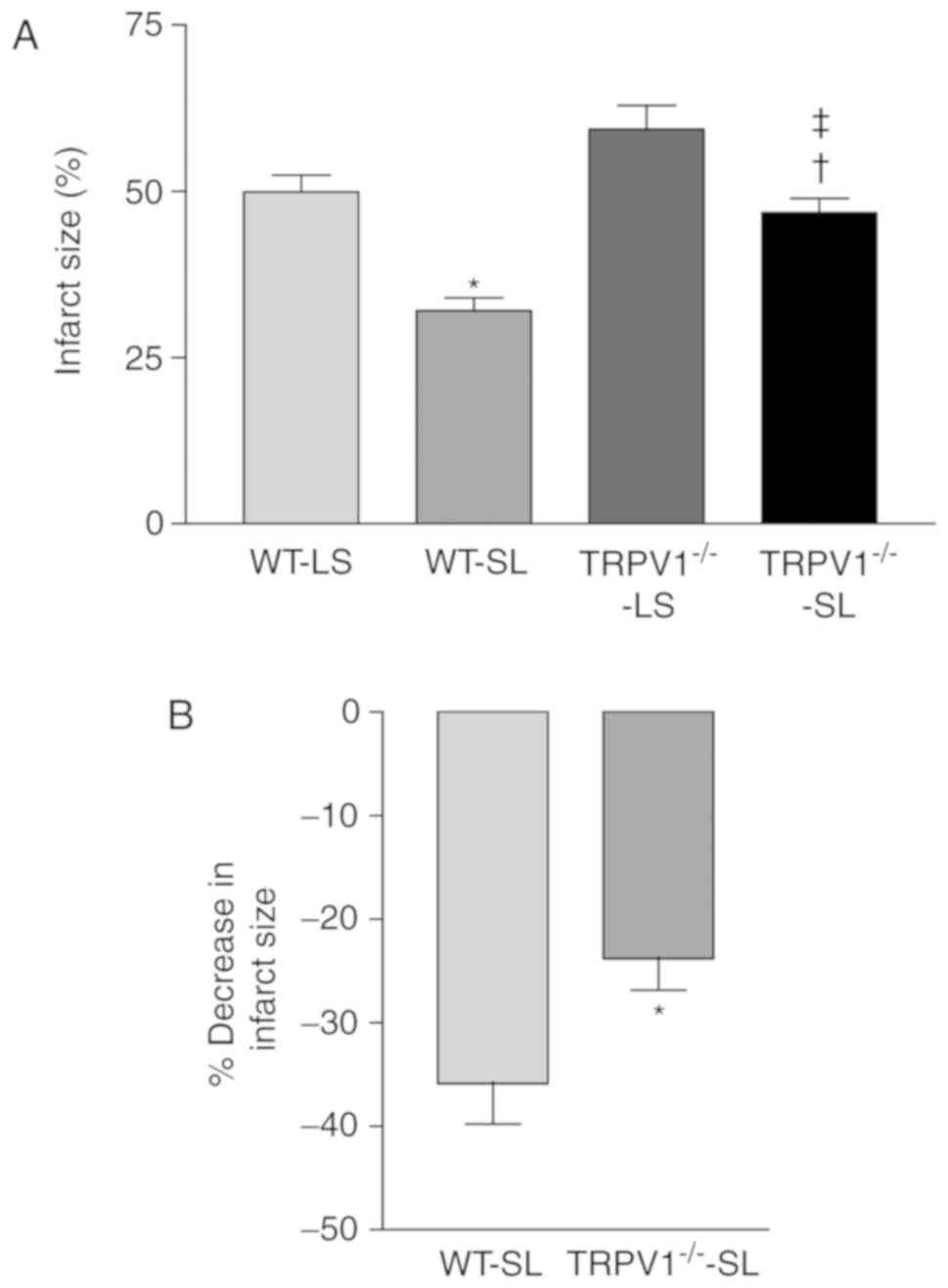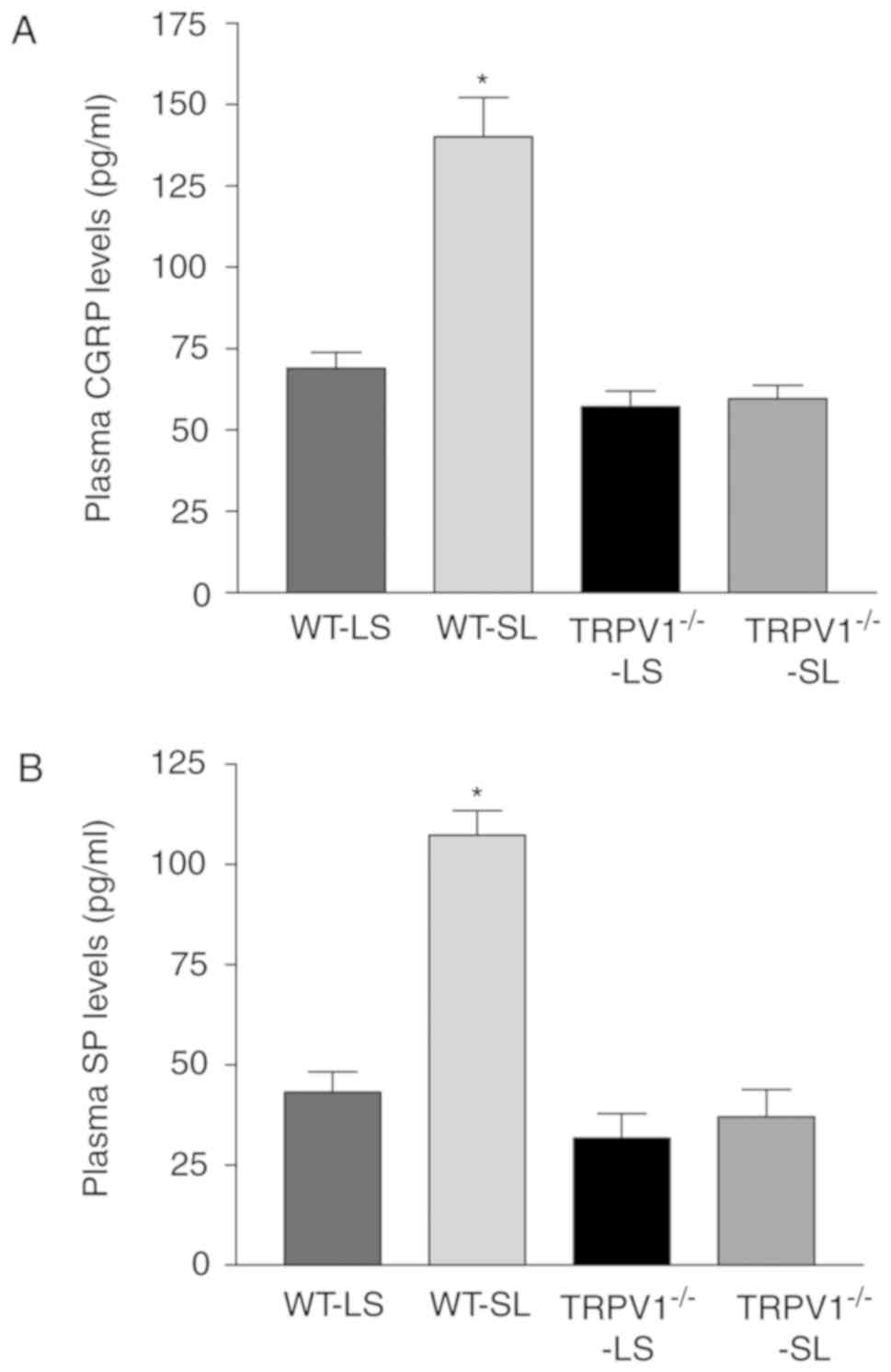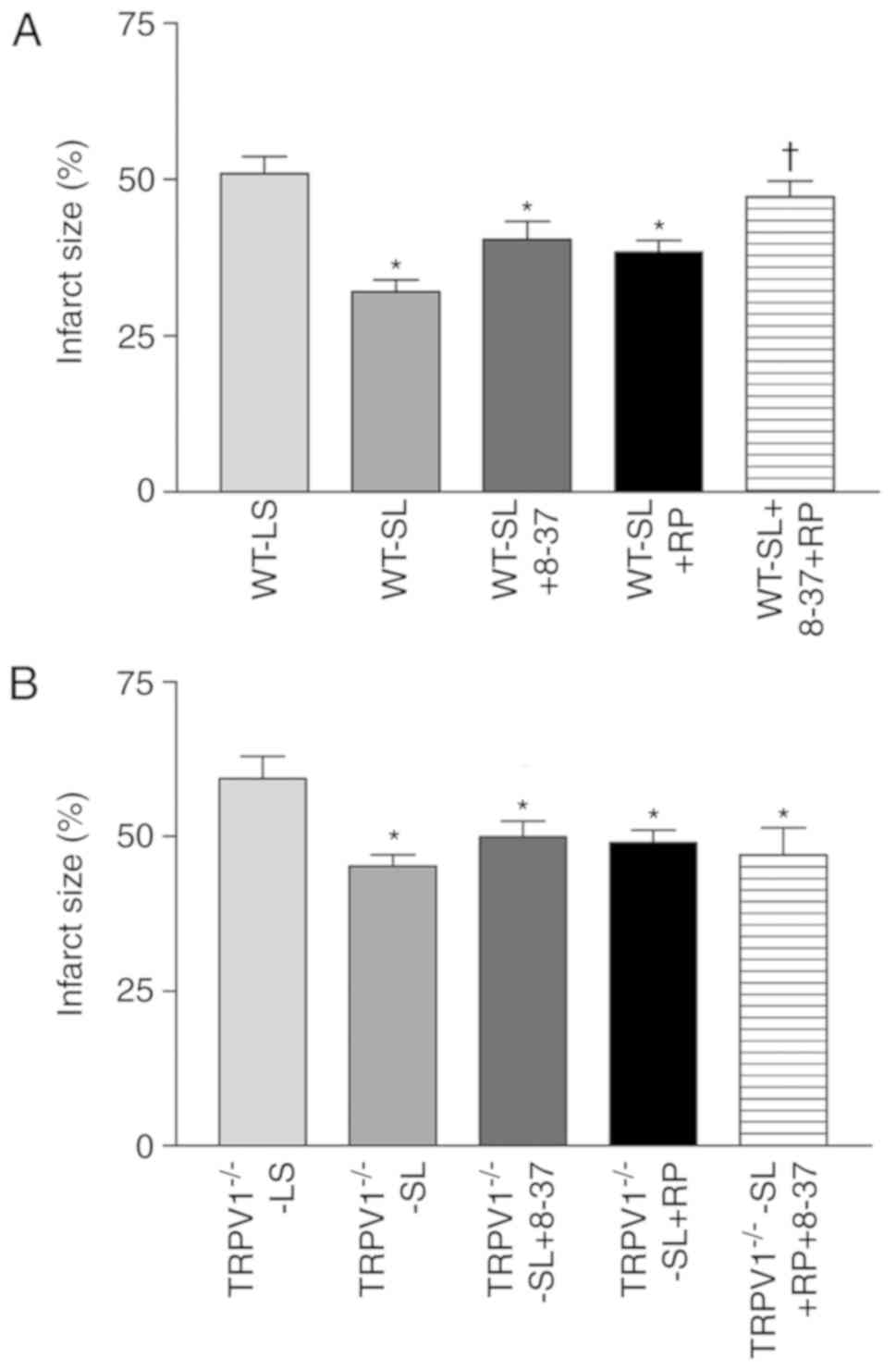|
1
|
Ossovskaya VS and Bunnett NW:
Protease-activated receptors: Contribution to physiology and
disease. Physiol Rev. 84:579–621. 2004. View Article : Google Scholar : PubMed/NCBI
|
|
2
|
Steinhoff M, Buddenkotte J, Shpacovitch V,
Rattenholl A, Moormann C, Vergnolle N, Luger TA and Hollenberg MD:
Proteinase-activated receptors: Transducers of proteinase-mediated
signaling in inflammation and immune response. Endocr Rev. 26:1–43.
2005. View Article : Google Scholar : PubMed/NCBI
|
|
3
|
Steinhoff M, Vergnolle N, Young SH,
Tognetto M, Amadesi S, Ennes HS, Trevisani M, Hollenberg MD,
Wallace JL, Caughey GH, et al: Agonists of proteinase-activated
receptor 2 induce inflammation by a neurogenic mechanism. Nat Med.
6:151–158. 2000. View
Article : Google Scholar : PubMed/NCBI
|
|
4
|
Gunthorpe MJ, Benham CD, Randall A and
Davis JB: The diversity in the vanilloid (TRPV) receptor family of
ion channels. Trends Pharmacol Sci. 23:183–191. 2002. View Article : Google Scholar : PubMed/NCBI
|
|
5
|
Caterina MJ, Leffler A, Malmberg AB,
Martin WJ, Trafton J, Petersen-Zeitz KR, Koltzenburg M, Basbaum AI
and Julius D: Impaired nociception and pain sensation in mice
lacking the capsaicin receptor. Science. 288:306–313. 2000.
View Article : Google Scholar : PubMed/NCBI
|
|
6
|
Dai Y, Moriyama T, Higashi T, Togashi K,
Kobayashi K, Yamanaka H, Tominaga M and Noguchi K:
Proteinase-activated receptor 2-mediated potentiation of transient
receptor potential vanilloid subfamily 1 activity reveals a
mechanism for proteinase-induced inflammatory pain. J Neurosci.
24:4293–4299. 2004. View Article : Google Scholar : PubMed/NCBI
|
|
7
|
McLean PG, Aston D, Sarkar D and Ahluwalia
A: Protease-activated receptor-2 activation causes EDHF-like
coronary vasodilation: Selective preservation in
ischemia/reperfusion injury: Involvement of lipoxygenase products,
VR1 receptors, and C-fibers. Circ Res. 90:465–472. 2002. View Article : Google Scholar : PubMed/NCBI
|
|
8
|
Zhong B and Wang DH: TRPV1 gene knockout
impairs preconditioning protection against myocardial injury in
isolated perfused hearts in mice. Am J Physiol Heart Circ Physiol.
293:H1791–H1798. 2007. View Article : Google Scholar : PubMed/NCBI
|
|
9
|
Napoli C, Cicala C, Wallace JL, de Nigris
F, Santagada V, Caliendo G, Franconi F, Ignarro LJ and Cirino G:
Protease-activated receptor-2 modulates myocardial
ischemia-reperfusion injury in the rat heart. Proc Natl Acad Sci
USA. 97:3678–3683. 2000. View Article : Google Scholar : PubMed/NCBI
|
|
10
|
Robin J, Kharbanda R, McLean P, Campbell R
and Vallance P: Protease-activated receptor 2-mediated
vasodilatation in humans in vivo: Role of nitric oxide and
prostanoids. Circulation. 107:954–959. 2003. View Article : Google Scholar : PubMed/NCBI
|
|
11
|
Hwang SW, Cho H, Kwak J, Lee SY, Kang CJ,
Jung J, Cho S, Min KH, Suh YG, Kim D and Oh U: Direct activation of
capsaicin receptors by products of lipoxygenases: Endogenous
capsaicin-like substances. Proc Natl Acad Sci USA. 97:6155–6160.
2000. View Article : Google Scholar : PubMed/NCBI
|
|
12
|
Starkopf J, Andreasen TV, Bugge E and
Ytrehus K: Lipid peroxidation, arachidonic acid and products of the
lipoxygenase pathway in ischaemic preconditioning of rat heart.
Cardiovasc Res. 37:66–75. 1998. View Article : Google Scholar : PubMed/NCBI
|
|
13
|
Yet SF, Tian R, Layne MD, Wang ZY, Maemura
K, Solovyeva M, Ith B, Melo LG, Zhang L, Ingwall JS, et al:
Cardiac-specific expression of heme oxygenase-1 protects against
ischemia and reperfusion injury in transgenic mice. Circ Res.
89:168–173. 2001. View Article : Google Scholar : PubMed/NCBI
|
|
14
|
Cattaruzza F, Cenac N, Barocelli E,
Impicciatore M, Hyun E, Vergnolle N and Sternini C: Protective
effect of proteinase-activated receptor 2 activation on motility
impairment and tissue damage induced by intestinal
ischemia/reperfusion in rodents. Am J Pathol. 169:177–188. 2006.
View Article : Google Scholar : PubMed/NCBI
|
|
15
|
Zhong B and Wang DH: N-oleoyldopamine, a
novel endogenous capsaicin-like lipid, protects the heart against
ischemia-reperfusion injury via activation of TRPV1. Am J Physiol
Heart Circ Physiol. 295:H728–H735. 2008. View Article : Google Scholar : PubMed/NCBI
|
|
16
|
Hochhauser E, Alterman I, Weinbroum A,
Barak Y, Harell D, Raz A, Erman A and Vidne B: Effects of
vasoactive substances released from ischemic reperfused liver on
the isolated rat heart. Exp Clin Cardiol. 6:29–34. 2001.PubMed/NCBI
|
|
17
|
Nayeem MA, Ponnoth DS, Boegehold MA,
Zeldin DC, Falck JR and Mustafa SJ: High-salt diet enhances mouse
aortic relaxation through adenosine A2A receptor via CYP
epoxygenases. Am J Physiol Regul Integr Comp Physiol.
296:R567–R574. 2009. View Article : Google Scholar : PubMed/NCBI
|
|
18
|
Zhong B and Wang DH: Protease-activated
receptor 2-mediated protection of myocardial ischemia-reperfusion
injury: Role of transient receptor potential vanilloid receptors.
Am J Physiol Regul Integr Comp Physiol. 297:R1681–R1690. 2009.
View Article : Google Scholar : PubMed/NCBI
|
|
19
|
Amadesi S, Cottrell GS, Divino L, Chapman
K, Grady EF, Bautista F, Karanjia R, Barajas-Lopez C, Vanner S,
Vergnolle N and Bunnett NW: Protease-activated receptor 2
sensitizes TRPV1 by protein kinase Cepsilon- and A-dependent
mechanisms in rats and mice. J Physiol. 575:555–571. 2006.
View Article : Google Scholar : PubMed/NCBI
|
|
20
|
Starr A, Graepel R, Keeble J, Schmidhuber
S, Clark N, Grant A, Shah AM and Brain SD: A reactive oxygen
species-mediated component in neurogenic vasodilatation. Cardiovasc
Res. 78:139–147. 2008. View Article : Google Scholar : PubMed/NCBI
|
|
21
|
Wang DH: The vanilloid receptor and
hypertension. Acta Pharmacol Sin. 26:286–294. 2005. View Article : Google Scholar : PubMed/NCBI
|
|
22
|
Wang L and Wang DH: TRPV1 gene knockout
impairs postischemic recovery in isolated perfused heart in mice.
Circulation. 112:3617–3623. 2005. View Article : Google Scholar : PubMed/NCBI
|
|
23
|
Athanasiou A, Smith PA, Vakilpour S,
Kumaran NM, Turner AE, Bagiokou D, Layfield R, Ray DE, Westwell AD,
Alexander SP, et al: Vanilloid receptor agonists and antagonists
are mitochondrial inhibitors: How vanilloids cause non-vanilloid
receptor mediated cell death. Biochem Biophys Res Commun.
354:50–55. 2007. View Article : Google Scholar : PubMed/NCBI
|
|
24
|
Nilius B, Owsianik G, Voets T and Peters
JA: Transient receptor potential cation channels in disease.
Physiol Rev. 87:165–217. 2007. View Article : Google Scholar : PubMed/NCBI
|
|
25
|
Wang Y, Babánková D, Huang J, Swain GM and
Wang DH: Deletion of transient receptor potential vanilloid type 1
receptors exaggerates renal damage in deoxycorticosterone
acetate-salt hypertension. Hypertension. 52:264–270. 2008.
View Article : Google Scholar : PubMed/NCBI
|
|
26
|
Helyes Z, Elekes K, Németh J, Pozsgai G,
Sándor K, Kereskai L, Börzsei R, Pintér E, Szabó A and Szolcsányi
J: Role of transient receptor potential vanilloid 1 receptors in
endotoxin-induced airway inflammation in the mouse. Am J Physiol
Lung Cell Mol Physiol. 292:L1173–L1181. 2007. View Article : Google Scholar : PubMed/NCBI
|
|
27
|
Brain SD, Williams TJ, Tippins JR, Morris
HR and MacIntyre I: Calcitonin gene-related peptide is a potent
vasodilator. Nature. 313:54–56. 1985. View Article : Google Scholar : PubMed/NCBI
|
|
28
|
Asimakis GK, DiPette DJ, Conti VR, Holland
OB and Zwischenberger JB: Hemodynamic action of calcitonin
gene-related peptide in the isolated rat heart. Life Sci.
41:597–603. 1987. View Article : Google Scholar : PubMed/NCBI
|
|
29
|
Li W, Wang T, Ma C, Xiong T, Zhu Y and
Wang X: Calcitonin gene-related peptide inhibits
interleukin-1beta-induced endogenous monocyte chemoattractant
protein-1 secretion in type II alveolar epithelial cells. Am J
Physiol Cell Physiol. 291:C456–C465. 2006. View Article : Google Scholar : PubMed/NCBI
|
|
30
|
Harzenetter MD, Novotny AR, Gais P, Molina
CA, Altmayr F and Holzmann B: Negative regulation of TLR responses
by the neuropeptide CGRP is mediated by the transcriptional
repressor ICER. J Immunol. 179:607–615. 2007. View Article : Google Scholar : PubMed/NCBI
|
|
31
|
O'Connor TM, O'Connell J, O'Brien DI,
Goode T, Bredin CP and Shanahan F: The role of substance P in
inflammatory disease. J Cell Physiol. 201:167–180. 2004. View Article : Google Scholar : PubMed/NCBI
|
|
32
|
Kramer JH, Phillips TM and Weglicki WB:
Magnesium-deficiency-enhanced post-ischemic myocardial injury is
reduced by substance P receptor blockade. J Mol Cell Cardiol.
29:97–110. 1997. View Article : Google Scholar : PubMed/NCBI
|
|
33
|
Souza DG, Mendonça VA, de A Castro MS,
Poole S and Teixeira MM: Role of tachykinin NK receptors on the
local and remote injuries following ischaemia and reperfusion of
the superior mesenteric artery in the rat. Br J Pharmacol.
135:303–312. 2002. View Article : Google Scholar : PubMed/NCBI
|
|
34
|
Grant AD, Cottrell GS, Amadesi S,
Trevisani M, Nicoletti P, Materazzi S, Altier C, Cenac N, Zamponi
GW, Bautista-Cruz F, et al: Protease-activated receptor 2
sensitizes the transient receptor potential vanilloid 4 ion channel
to cause mechanical hyperalgesia in mice. J Physiol. 578:715–733.
2007. View Article : Google Scholar : PubMed/NCBI
|
|
35
|
Moriyama T, Higashi T, Togashi K, Iida T,
Segi E, Sugimoto Y, Tominaga T, Narumiya S and Tominaga M:
Sensitization of TRPV1 by EP1 and IP reveals peripheral nociceptive
mechanism of prostaglandins. Mol Pain. 1:32005. View Article : Google Scholar : PubMed/NCBI
|
|
36
|
Shinmura K, Tamaki K, Sato T, Ishida H and
Bolli R: Prostacyclin attenuates oxidative damage of myocytes by
opening mitochondrial ATP-sensitive K+ channels via the EP3
receptor. Am J Physiol Heart Circ Physiol. 288:H2093–H2101. 2005.
View Article : Google Scholar : PubMed/NCBI
|
|
37
|
Camitta MG, Gabel SA, Chulada P, Bradbury
JA, Langenbach R, Zeldin DC and Murphy E: Cyclooxygenase-1 and −2
knockout mice demonstrate increased cardiac ischemia/reperfusion
injury but are protected by acute preconditioning. Circulation.
104:2453–2458. 2001. View Article : Google Scholar : PubMed/NCBI
|
|
38
|
Sexton A, McDonald M, Cayla C, Thiemermann
C and Ahluwalia A: 12-Lipoxygenase-derived eicosanoids protect
against myocardial ischemia/reperfusion injury via activation of
neuronal TRPV1. FASEB J. 21:2695–2703. 2007. View Article : Google Scholar : PubMed/NCBI
|
|
39
|
Gross GJ, Falck JR, Gross ER, Isbell M,
Moore J and Nithipatikom K: Cytochrome P450 and arachidonic acid
metabolites: Role in myocardial ischemia/reperfusion injury
revisited. Cardiovasc Res. 68:18–25. 2005. View Article : Google Scholar : PubMed/NCBI
|
|
40
|
Ding Z, Gödecke A and Schrader J:
Contribution of cytochrome P450 metabolites to bradykinin-induced
vasodilation in endothelial NO synthase deficient mouse hearts. Br
J Pharmacol. 135:631–638. 2002. View Article : Google Scholar : PubMed/NCBI
|

















